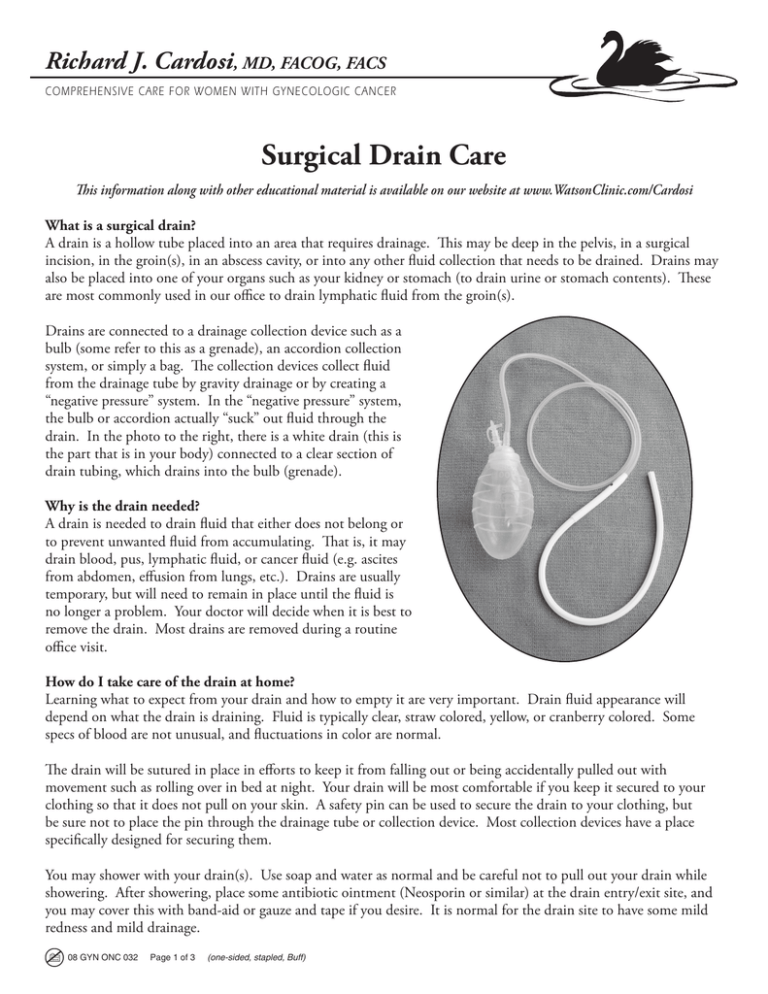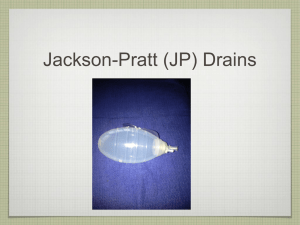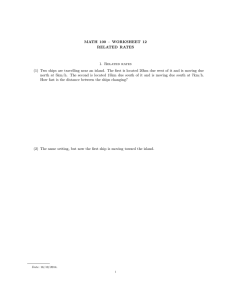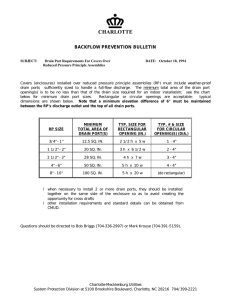Surgical Drain Care
advertisement

Richard J. Cardosi, MD, FACOG, FACS COMPREHENSIVE CARE FOR WOMEN WITH GYNECOLOGIC CANCER Surgical Drain Care This information along with other educational material is available on our website at www.WatsonClinic.com/Cardosi What is a surgical drain? A drain is a hollow tube placed into an area that requires drainage. This may be deep in the pelvis, in a surgical incision, in the groin(s), in an abscess cavity, or into any other fluid collection that needs to be drained. Drains may also be placed into one of your organs such as your kidney or stomach (to drain urine or stomach contents). These are most commonly used in our office to drain lymphatic fluid from the groin(s). Drains are connected to a drainage collection device such as a bulb (some refer to this as a grenade), an accordion collection system, or simply a bag. The collection devices collect fluid from the drainage tube by gravity drainage or by creating a “negative pressure” system. In the “negative pressure” system, the bulb or accordion actually “suck” out fluid through the drain. In the photo to the right, there is a white drain (this is the part that is in your body) connected to a clear section of drain tubing, which drains into the bulb (grenade). Why is the drain needed? A drain is needed to drain fluid that either does not belong or to prevent unwanted fluid from accumulating. That is, it may drain blood, pus, lymphatic fluid, or cancer fluid (e.g. ascites from abdomen, effusion from lungs, etc.). Drains are usually temporary, but will need to remain in place until the fluid is no longer a problem. Your doctor will decide when it is best to remove the drain. Most drains are removed during a routine office visit. How do I take care of the drain at home? Learning what to expect from your drain and how to empty it are very important. Drain fluid appearance will depend on what the drain is draining. Fluid is typically clear, straw colored, yellow, or cranberry colored. Some specs of blood are not unusual, and fluctuations in color are normal. The drain will be sutured in place in efforts to keep it from falling out or being accidentally pulled out with movement such as rolling over in bed at night. Your drain will be most comfortable if you keep it secured to your clothing so that it does not pull on your skin. A safety pin can be used to secure the drain to your clothing, but be sure not to place the pin through the drainage tube or collection device. Most collection devices have a place specifically designed for securing them. You may shower with your drain(s). Use soap and water as normal and be careful not to pull out your drain while showering. After showering, place some antibiotic ointment (Neosporin or similar) at the drain entry/exit site, and you may cover this with band-aid or gauze and tape if you desire. It is normal for the drain site to have some mild redness and mild drainage. 08 GYN ONC 032 Page 1 of 3 (one-sided, stapled, Buff) It is important to keep the drain working properly by “milking” or “stripping” the drainage tube and emptying the collection bulb several times per day. Your nurse will show you how to “milk/strip” the drainage tube prior to hospital discharge, but it is reviewed below as well. Drainage instructions are also included below but will be reviewed prior to hospital discharge by your nurse. Home nursing arrangements can also be made for your convenience if desired. How do I “milk” or “strip” my drain? ◆ Wash your hands with soap and water prior to handling your drain. ◆ Firmly hold the drain at the insertion site with one hand (close to the skin); this will prevent the drain from being pulled out during the “stripping” or “milking” process. ◆ While still holding the drain in place, with the thumb and index finger of the other hand, pinch or squeeze the tubing. ◆ While squeezing, slide your thumb and index finger down the drain towards the collection bulb “stripping” or “milking” the contents towards the bulb. Do not release the pressure (pinching) on the drainage tube until you have “stripped” or “milked” the drain all the way to the bulb. ◆ Do this at least 4 times per day and every time you empty the drain. How do I empty the drain bulb? ◆ Wash your hands with soap and water prior to emptying your drain. ◆ Hold the drain securely and remove the plug from the drainage port. ◆ Turn the bulb upside down over a measuring device, and gently squeeze out the bulb contents. ◆ “Milk” or “strip” the drain tube each time you empty your bulb as described above. ◆ Squeeze the middle of the bulb, and while keeping it squeezed, replace the drainage plug (wipe plug with alcohol soaked cotton ball prior to replacing). It is important to keep it squeezed during this process, as this is what creates the suction for the drain. ◆ Measure how much drainage is emptied and record it along with the date and time. Keep separate measurements for each drain if you have more than one drain. A 24-hour running total should be kept as well. ◆ Discard the drainage fluid in the toilet. ◆ Empty the bulb anytime it becomes about half full, but do this at least three times per day. When do I call the office? ◆ If you develop increased pain or a spreading redness at the drain site ◆ If drainage in the bulb looks like pus ◆ If you have active bleeding ◆ If you have a temperature of 100.5 °F or higher ◆ If the drain quits draining ◆ If the drain falls out 1600 Lakeland Hills Boulevard 08 GYN ONC 032 Page 2 of 3 ◆ Lakeland, Florida 33805 ◆ 863-680-7578 ◆ Fax: 863-616-2415 ◆ www.WatsonClinic.com/Cardosi Richard J. Cardosi, MD, FACOG, FACS COMPREHENSIVE CARE FOR WOMEN WITH GYNECOLOGIC CANCER Record drain output in this table. Drain Output Running Total for 24 hours Date Time Amount 1600 Lakeland Hills Boulevard 08 GYN ONC 032 Page 3 of 3 ◆ Lakeland, Florida 33805 ◆ 863-680-7578 ◆ Fluid Color/Comments Fax: 863-616-2415 ◆ www.WatsonClinic.com/Cardosi




